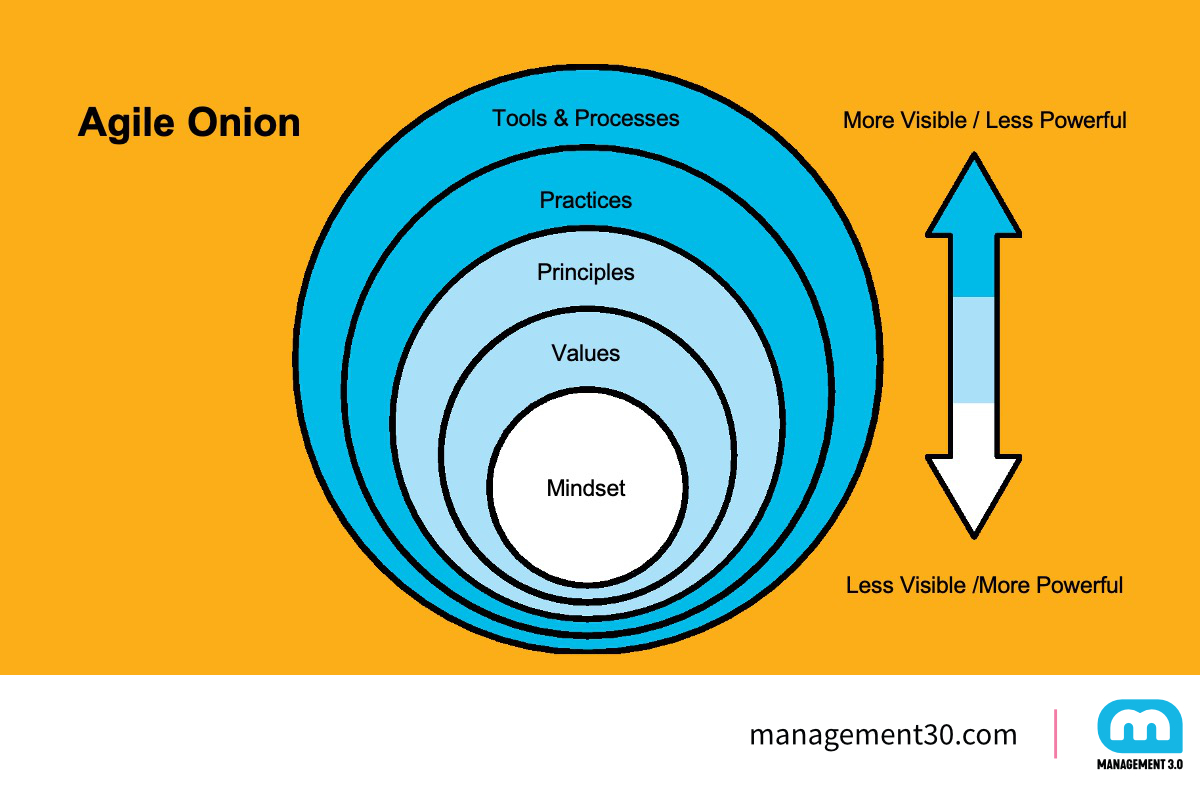In the realm of Management 3.0, we often discuss ways to make work more enjoyable, empower our teams, and foster a positive workplace culture. But have you ever wondered if these principles can be applied at the highest levels of an organization – the C-level executives? Is it feasible to discuss Management 3.0 practices with the company’s top decision-makers, and if so, how can you approach this? Mateus Rocha, a Management 3.0 Facilitator from Brazil, recently initiated a vital conversation within the Management 3.0 Membership Community. The discussion centers on an intriguing challenge: how can we introduce Management 3.0 concepts to the C-level, and what are the best strategies for doing so?
The Enthusiasm Dilemma
Picture this scenario: You’ve completed a Management 3.0 training program, refined your skills in subsequent Agile Leadership Workshops, and successfully implemented innovative practices like Feedback Lotteries and Delegation Boards. Your enthusiasm soars because you witness the tangible improvements in your team’s dynamics and productivity.
In this heightened state of enthusiasm, you aspire to introduce concepts like Moving Motivators and Personal Maps to your company’s top leaders – the C-level executives.
However, when the opportunity finally arrives, something unexpected transpires. Your enthusiasm and excitement aren’t mirrored on the faces of the C-level. Instead, you encounter perplexed expressions, muted responses, and a sense of disconnection.
This situation is not uncommon, and it presents a challenge that many of us have faced.
Bridging the Enthusiasm Gap
The fundamental truth is that C-level executives may not share the same level of enthusiasm for the intricate details of Management 3.0 as you do. They may not be as excited about activities like playing the Change Management Game or participating in a meeting with Improv Cards.
But there is hope:
When you introduce practices from Management 3.0, such as Delegation Poker, or embrace its underlying principles, it yields concrete results. Importantly, it’s these results that C-level executives typically care deeply about.
The Quest for Alignment
In this article, we will explore strategies and insights aimed at bridging the communication gap between Management 3.0 enthusiasts and C-level executives. We’ll illustrate how introducing Management 3.0 at the highest organizational levels can be transformative.
Understanding the C-Level
Before we proceed, let’s clarify who the C-Level executives are. This term refers to the top-ranking individuals in an organization, typically holding titles that begin with “C,” such as CEO (Chief Executive Officer), CFO (Chief Financial Officer), or CTO (Chief Technology Officer). These executives bear critical responsibilities, including setting corporate strategy, making strategic decisions, leading the executive team, managing financial performance, and representing the company to external stakeholders.
Their focus extends beyond short-term results, encompassing the organization’s long-term performance, often spanning over a multi-year horizon.
Aligning Visions: Management 3.0 and C-Level Leadership
While Management 3.0 emphasizes a flexible mindset and employs evolving tools and games to assist professionals, the primary goal is to empower individuals in managing their organizations effectively.
However, there is a distinct difference:
C-level executives are primarily concerned with steering the company toward sustained success, while Management 3.0 is about helping teams progress and grow.
Can these two perspectives coexist? Absolutely.
Yet, it is crucial to realize that communicating the same message to both Management 3.0 enthusiasts and C-level executives may not fully resonate with the priorities of top leadership.
Results vs. Management 3.0 Practices
Put yourself in the shoes of a CEO for a moment. If you had to choose between your employees achieving tangible results or adopting specific Management 3.0 practices, the decision seems straightforward, right?
In reality, C-level executives focus on the “bottom line” – the outcomes that significantly impact the company’s success. They ask questions like, “Are we reducing costs? Are we making cost-effective hiring decisions? Are more employees staying with the company? Is our brand gaining value in the market?”
These questions reflect their results-oriented mindset, aligning with their high-level concerns.
The Agile Onion: Unveiling the Core
To illustrate the transition from mindset to practice, think of the “Agile Onion.” This model consists of five interconnected layers, culminating at the core. These layers include Mindset, Values, Principles, Practices, and tools and processes.
While the mindset serves as a robust foundation, making it tangible can be challenging. Simultaneously, implementing processes and practices, even if they are less potent, offers more visibility. They serve as a window into the underlying mindset, translating powerful ideas into practical actions.

Gaining C-Level Support for Management 3.0: Practical Steps
Speak Their Language
When introducing Management 3.0 to C-level executives, it’s essential not to begin with games and practices, which may appear abstract. Instead, emphasize the outcomes, such as enhanced employee engagement and cost optimization. Explain how these approaches address genuine challenges faced by the C-level, like reducing the cost of poor hiring decisions or amplifying the sense of purpose within the organization.
Illustrate that there’s a problem that you can help solve.
For instance, consider the substantial cost of hiring the wrong individuals, which can be exceedingly expensive. Research suggests that the total cost of an employee can be 1.5 to 3 times their salary. This presents a tangible issue that aligns with the C-level’s concerns about optimizing costs while making strategic hiring decisions.
Another example relates to the benefits of having a clear sense of purpose. Companies with a strong sense of purpose tend to be more financially successful and their teams are more productive. This translates into a win-win situation. You’re essentially conveying the message that “Investing in purpose not only leads to greater financial success but also results in happier shareholders and larger bonuses for everyone.” This type of value proposition can pique their interest.
This is the typical approach when engaging with C-level executives. Instead of immediately delving into specific tools and practices, I present concepts that are relevant to their everyday business challenges, making Management 3.0 accessible and demonstrating its capacity to address their specific needs.
Plan with Precision
CEOs prefer concrete plans. Even if your plan is to run an experiment, outline the problem, how you’ll tackle it, and when you’ll present results. Ensure that your approach combines the right mindset with tangible actions to maintain their attention.
Showcase Real Success Stories
C-level executives are results-oriented. Present them with concrete cases that demonstrate the effectiveness of Management 3.0 practices.
Management 3.0 is not a rigid framework, allowing you to draw from a variety of examples, even those that go beyond the direct application of Management 3.0 practices. For instance, you can showcase initiatives like Nubank’s “failure day,” TOMS’ employee purpose programs, Dengo’s innovative approach to the circular economy by involving cocoa suppliers in chocolate production, or Buurtzorg’s unique methods of delegation and indirect leadership. These real-world examples help underscore the benefits of your approach.
Experiment and Innovate
Begin with enthusiasts and innovators within the organization. These early adopters can help prove the value of Management 3.0. Be open to experimenting and embrace resistance as a sign that an approach isn’t suitable for certain areas. This keeps momentum and motivation high.
Share Results for the Right Reasons
Share results with the aim of advancing the cause, not for personal gain. When you implement a practice like Delegation Poker and it works well with one group, consider carefully the approach to scaling it for other teams. The intention should be to enhance the organization, not simply to accumulate “points for the next level.” Scaling Management 3.0 should be a thoughtful process driven by the desire to improve the entire organization, aligning with the principles of Management 3.0.
Foster a Company-Wide Movement
To drive change, create movements within your organization. For instance, if you want to encourage innovation, organize an innovation event and secure funding and involvement. However, remember that for this movement to truly take root, it is essential to involve HR and the specific business unit you intend to positively impact. This inclusivity generates a sense of ownership rather than mere involvement, ensuring that the principles of Management 3.0 become an integral part of your company’s culture.

Conclusion: Aligning Perspectives for Success
In summary, introducing Management 3.0 to C-level executives is not only a good idea but a strategic necessity for agile organizations. To bridge the gap, you must communicate in a language that resonates with the C-level’s results-focused mindset and address their specific challenges. The key is to demonstrate how Management 3.0 can help solve genuine problems, leveraging real success stories and creating a movement within your organization. By aligning the visions of Management 3.0 enthusiasts and C-level executives, you can lead your organization to transformative results and sustained success.

